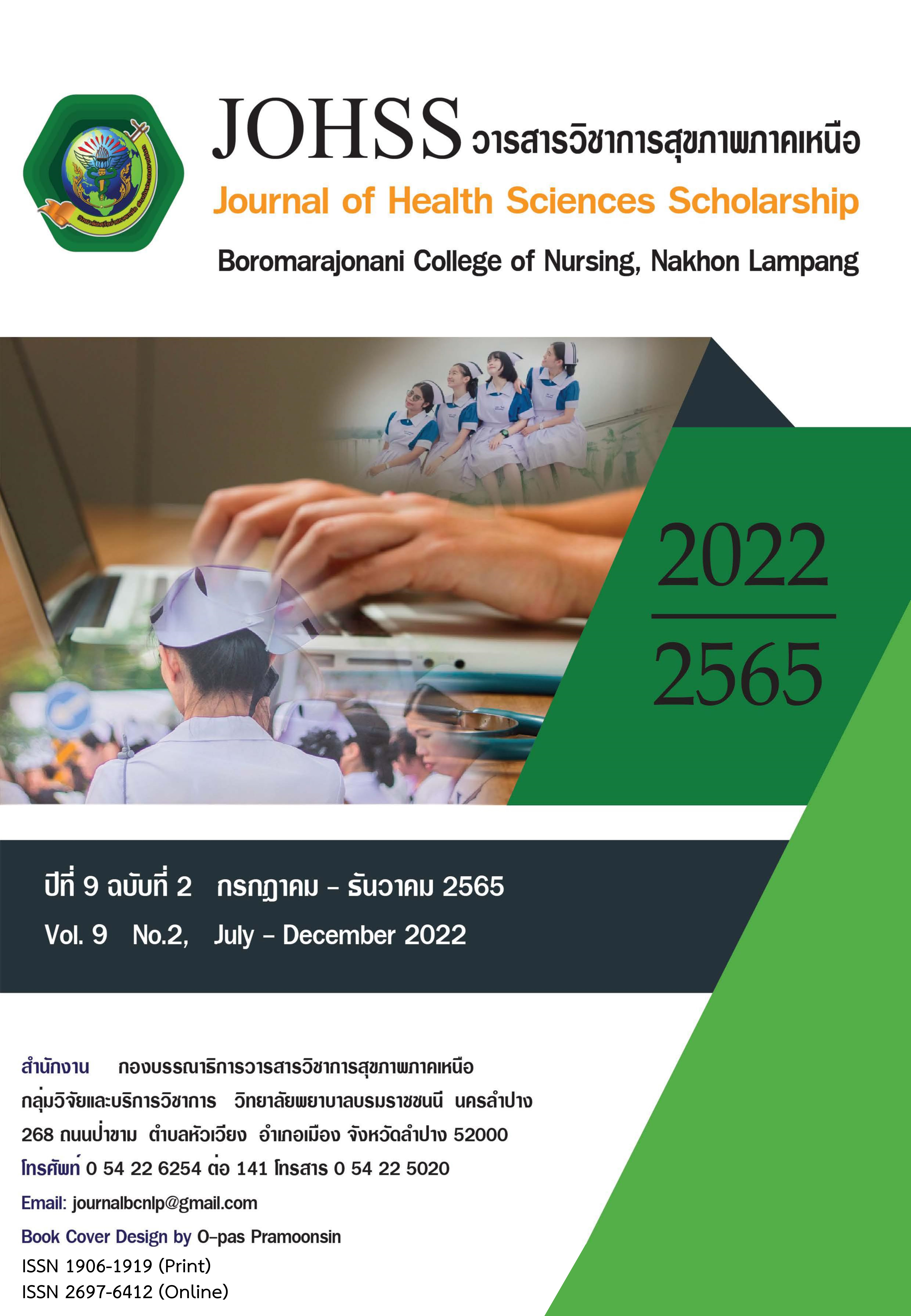ผลของการใช้แนวปฏิบัติการพยาบาลในการเตรียมความพร้อมผู้ป่วยโรคไตเรื้อรังระยะสุดท้ายที่ได้รับการฟอกเลือดด้วยเครื่องไตเทียมต่อการเกิดภาวะความดันโลหิตต่ำขณะฟอกเลือด
คำสำคัญ:
แนวปฏิบัติการพยาบาล, การฟอกเลือด, ผู้ป่วยโรคไตเรื้อรังระยะสุดท้าย, ภาวะความดันโลหิตต่ำขณะฟอกเลือดบทคัดย่อ
การวิจัยกึ่งทดลองครั้งนี้ มีวัตถุประสงค์เพื่อศึกษาผลของการใช้แนวปฏิบัติต่อการเกิดภาวะความดันโลหิตต่ำขณะฟอกเลือด ณ ศูนย์ไตเทียม 1 โรงพยาบาลแพร่ กลุ่มตัวอย่างคือ ผู้ป่วยโรคไตเรื้อรังระยะสุดท้ายที่ได้รับการฟอกเลือดด้วยเครื่องไตเทียม แบ่งเป็นกลุ่มทดลอง 52 คน กลุ่มควบคุม 52 คน โดยใช้วิธีการสุ่มตัวอย่างแบบง่าย เครื่องมือที่ใช้ในการวิจัย ได้แก่ 1) แนวปฏิบัติการพยาบาลในการเตรียมความพร้อมผู้ป่วยโรคไตเรื้อรังระยะสุดท้ายที่ได้รับการฟอกเลือดด้วยเครื่องไตเทียม ประกอบด้วย ก) การให้ความรู้เกี่ยวกับการฟอกเลือดด้วยเครื่องไตเทียม ข) การเตรียมผู้ป่วยก่อนเข้ารับการฟอกเลือดด้วยเครื่องไตเทียมและ ค) การพยาบาลขณะรับการฟอกเลือดด้วยเครื่องไตเทียม และ 2) แบบบันทึกรายงานการฟอกเลือด วิเคราะห์ข้อมูลด้วยสถิติเชิงพรรณนา สถิติฟิชเชอร์ เอกแซค และ สถิติ ที
ผลการศึกษา พบว่า กลุ่มทดลองมีจำนวนครั้งของการเกิดภาวะความดันโลหิตต่ำขณะฟอกเลือดน้อยกว่ากลุ่มควบคุมอย่างมีนัยสำคัญทางสถิติ (p = .01) และมีค่าความดันซีสโตลิกและดันไดแอสโตลิกสูงกว่ากลุ่มควบคุมอย่างมีนัยสำคัญทางสถิติ (p < .001) พยาบาลและบุคลากรทางด้านสุขภาพ ควรนำแนวปฏิบัติการพยาบาลนี้ไปใช้ในการเตรียมความพร้อมผู้ป่วยที่ได้รับการฟอกเลือดด้วยเครื่องไตเทียม
เอกสารอ้างอิง
Chou, J. A., Streja. E., Nguyen, D. V., Rhee, C. M., Obi, Y., Inrig, J. K., Amon, A., Kovesdt, C.
P., Sim, J. J., & Kalantar-Zadeh, K. (2018). Intradialytic hypotension, blood pressure
changes and mortality risk in incident hemodialysis patients. Nephrol Dial
Transplant, 33(1), 149-159.
Department of medical record. (2019). Clinical risk report. Phare Hospital.
Flythe, J. E., Xue, H., Lynch, K. E., Curhan, G. C., & Brunelli, S. M. (2015). Association of
mortality risk with various definitions of intradialytic hypotension. Journal of the
American Society of Nephrology, 26(3), 724–734.
Jolawong, O., Munsil, J., & Taweewanich, S. (2018). Application of evidence-based practice
in nursing professionals. Journal of the Thai Army Nurses, 19(2), 8-14. (In Thai).
Khuenkum, B. (2020). Development Clinical Nursing Practice Guideline for Acute Kidney
Injury Patients with Continuous Renal Replacement Therapy in Medical Intensive
Care Unit Nakornping Hospital, Chiang Mai Province. Journal of Nakornping
Hospital, 11(2), 64-86. (in Thai).
Kittirakpanya,W., Samartkit, N., & Masingboon, K. (2013). Impacts of the co-application of
self-management and clinical management programme on management
behaviour, increased weight and intradialytic hypotension in chronic kidney disease patients treated with hemodialysis. Thai Journal of Nursing Council, 28(2), 109-12. (in Thai).
National Health and Medical Research Council (NHMRC). (1999). A guide to the
developmental, implementation and evaluation of clinical practice guidelines. Retrieved (2018, 10 April) from http://www.nhmrc.gov.au/_files_nhmrc/file/publications/synopses/cp30.p
Noparit, P., & Promdee, A. (2519). Development of clinical nursing guideline for palliative
care in patients with end stage renal disease Mukdahan hospital. Mahasarakham hospital journal, 16(3), 96-108. (in Thai).
Okoye, O. C., Slater, H. H., & Rajora, N. (2017). Prevalence and risk factors of intra-dialytic hypotension: a 5-year retrospective report from a single Nigerian Centre. The Pan African Medical Journal. 28(62), 1-6.
Payoomprom, P., Pirunthong, S., Thorsang, Ch., & Sutthum, A. (2016). Development of Clinical Nursing Practice Guides for Chronic Kidney Disease Patients at Chaiyaphum Hospital. Journal of Nursing Division, 43(1), 12-33. (in Thai).
Puengchompoo, W. (2016). Nursing care of persons with chronic kidney disease receiving hemodialysis. Chiang Mai: Samnakphim Mahawitthayalai Chiang Mai. (in Thai).
Sars, B., M. van der Sande, F., & Kooman, J., (2020). Intradialytic hypotension: Mechanisms and outcome. Blood Purif, 49(2), 159-166.
Sands, J. J., Usvyat, L.A., Sullivan, T., Segal, J. H., Zabetakis, P., Kotanko, P., Maddux, F. W., & Diaz-Buxo, J.A. (2014). Intradialytic hypotension: Frequency, sources of variation and correlation with clinical outcome. Hemodialysis International, 18(2), 415-422.
Sangsee, P., Tanatwanit, Y., Kunsongkiet, W., & Moumgkum, S. (2020). Factors Related to Self-determination to Select Dialysis Modalities in Patients with End-stage renal diseases. The Journal of Faculty of Nursing Burapha University, 28(3), 53-65. (in Thai).
Soukup, S. M. (2000). Evidence-based Practice Model Promoting the Scholarship of Practice. Nursing Clinic of North America. Philadelphia: WB Saunders.
Vongchaiudomchoke, T. (2019). Risk factors for Intradialytic hypotension during hemodialysis among the end-stage renal disease patients with pre-existing autonomic dysfunction. Lampang Medicine Journal, 40(2), 50-59. (In Thai).
ดาวน์โหลด
เผยแพร่แล้ว
ฉบับ
ประเภทบทความ
สัญญาอนุญาต
ลิขสิทธิ์ (c) 2022 วารสารวิชาการสุขภาพภาคเหนือ

อนุญาตภายใต้เงื่อนไข Creative Commons Attribution-NonCommercial-NoDerivatives 4.0 International License.
บทความ ข้อมูล เนื้อหา รูปภาพ ฯลฯ ที่ได้รับการตีพิมพ์ในวารสารวารสารวิชาการสุขภาพภาคเหนือ ถือเป็นลิขสิทธิ์ของวารสารวารสารวิชาการสุขภาพภาคเหนือ หากบุคคลหรือหน่วยงานใดต้องการนำทั้งหมดหรือส่วนหนึ่งส่วนใดไปเผยแพร่ต่อหรือเพื่อกระทำการใดๆ จะต้องได้รับอนุญาตเป็นลายลักอักษรจากวารสารวารสารวิชาการสุขภาพภาคเหนือก่อนเท่านั้น
เนื้อหาและข้อมูลในบทความที่ลงตีพิมพ์ในวารสารวิชาการสุขภาพภาคเหนือถือเป็นข้อคิดเห็นและความรับผิดชอบของผู้เขียนบทความโดยตรงซึ่งกองบรรณาธิการวารสาร ไม่จำเป็นต้องเห็นด้วย หรือร่วมรับผิดชอบใดๆ
อนึ่ง ข้อความและข้อคิดเห็นต่างๆ เป็นของผู้เขียนบทความนั้นๆ ไม่ถือเป็นความเห็นของวารสารฯ และวารสารฯ ไม่จำเป็นต้องเห็นด้วยกับข้อความและข้อคิดเห็นใดๆ ของผู้เขียน วารสารฯ ขอสงวนสิทธิ์ในการพิจารณาตีพิมพ์ตามความเหมาะสม รวมทั้งการตรวจทานแก้ไขหรือขัดเกลาภาษาให้ถูกต้องตามเกณฑ์ที่กำหนด



